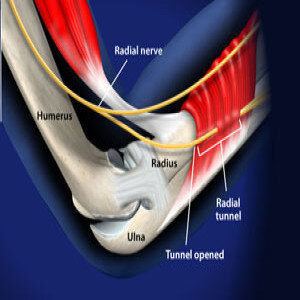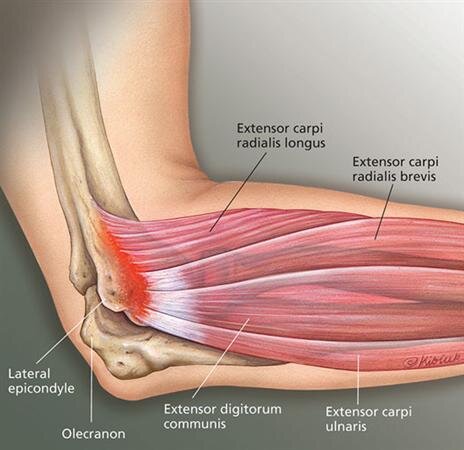Why You Get Elbow Pain When Lifting Weights
Weight training is one of the sweet nectars in life, but even its magnificence can have an unappealing side effect or two. One of those effects lacking appeal is elbow pain. We may not all feel it, yet a good amount of us deal with a degree of this hinge joint’s anguish somewhere along the way. To come is what to do to prevent or rid yourself of the nuisance - first a foundation. What is the elbow’s job.
SECTIONS:
elbow Pain When Lifting Weights
What Is The Elbow’s Function
The elbow is a hinge joint that connects the humerus, ulna, and radius bones. This set up allows for a degree of rotation, but pun intended, it makes its bones with flexion and extension.
[9]
Part of the beauty of your elbow joints is the possession of synovial fluid. This fluid is lubricated cartilage designed to minimize friction for ease of motion and to lower degradation over time. Still, shit happens. The elbow allows flexion and extension of the forearm, however without proper precaution this can become an issue one day or another.
[11]
Causes Of Weight Lifting Elbow Pain
Pain at the elbow pains my heart, especially when it gets you pondering. That “i have no clue why I’m hurting” pain is different. Impact, traumatic injuries speak for themselves. Unexplained pain needs a light shined upon it.
So the elbow is quite involved in much of what you do whether weight training, playing tennis, baseball, carpentry, plumbing, or so on. Not only are these involved acts, they call for repetitive movements.. Anything repetitive can lead to “mileage” issues. There’s actually a name for them: repetitive strain injuries (RSI).
In case of the elbow some common diagnoses are:
Elbow bursitis
Radial tunnel syndrome
Biceps tendinopathy
Weightlifter’s elbow
Tennis elbow
Golfer’s elbow
Each slightly different in nature, yet the causes and treatments happen to be strikingly similar when today’s highlighted hinge joint is involved.
RSIs often seem insignificant and like something you can “play through” which can be the case if proper measures are taken. If you play through as if nothing is unfolding you will suffer in time and be forced to take heed.
There are two general categories for your elbow struggles: inflammation and/or degeneration aka tendonitis or tendinosis.
Tendonitis is inflammation of a tendon. Tendinosis is the degeneration of collagen in a tendon.
Each results in pain, still with varying meanings. Tendonitis’ pain signals indicate “we’re working on it” - could’ve been trauma or microtears causing the inflammatory response. Tendinosis signals are saying “yo, you need to chill” time to recover asap. You’ve ignored the signs I’ve given you for too long.
A good way to know the difference is how long you’ve felt the abnormality. Suddenly is likely tendonitis, gradually increasing in severity is more likely to be tendinosis.
Tendons connected to the elbow are in the mix with frequency. Remember a tendon is what connects bone to muscle, but they do gain strength and mass just at a slower pace. This is why it’s not unexpected for new lifters or lifters jumping from low-moderate volume to high volume training too soon to go through the grief.
Note: volume is reference to the amount of weight lifted, number of sets, and number of reps.
Another note: tendons don’t receive ample blood supply, so recovery tends to go a lot more slowly. Best to handle issues immediately rather than waiting for a severe case of tendinosis.
Practices that can lead to these issues:
Lack of, or improper warm up
Too much volume too soon, especially with exercises involving elbow flexion and/or extension IE bicep curls, tricep pushdowns, bench press, etc
Not enough variance, overuse - as strong as one may be our bodies have limits
Pressure for long periods IE elbows on a desk at work
Occupations with repetition involving the forearm to elbow complex like factory work
Regular supination or pronation (twisting of the wrist)
Insufficient recovery time between sessions with the same muscle groups
Weakness in supporting muscles
What Are Symptoms Of An Elbow Overuse Injury
Pain disseminating from and around the elbow
Noticeable redness
Loose skin at the elbow’s tip
Inflammation as response to microtears
Visible swelling - rare, yet when this occurs minus force trauma take it as a sign
Numbness or tingling of, or around the elbow - sometimes a radiating sensation
Tender to the touch.. Hypersensitivity
Hot to the touch
Stiffness - almost a feeling as if there’s no synovial fluid
Progressive pain without relevant relief
What Is Elbow Bursitis
“Elbow bursitis occurs in the olecranon bursa, a thin, fluid-filled sac that is located at the boney tip of the elbow (the olecranon).” [2]
[2]
Bursae are all around the body, they act as a sort of padding between delicate tissue and bones, for without things would be.. Rough. These bursae contain lubricant that allows free movement over the particular bone and under soft tissue such as muscle, tendons, ligaments, and skin.
Bursitis occurs when bursae become inflamed. They’re usually flat, all the same some source of irritation causes them to amass excess fluid, which leads to pain and stiffness.
What Is Radial Tunnel Syndrome
Radial tunnel syndrome aka radial nerve entrapment is a condition in which pain shows itself on the lateral side of your elbow - continuing down into your hand.
[12]
The radial nerve is located alongside the muscles of the forearm running from the hand all the way to your neck. When compression or pinching occurs - here we find ourselves.
Your muscles, tendon, and bone complex form a tunnel at the elbow in which the radial nerve runs through. This is called the radial tunnel hence radial tunnel syndrome to describe the dull chronic aching sensation.
What Is Biceps Tendinopathy
Is everyday arm day? Do you curl like nobody’s business? Do you have unexplained pain? It’s possible you’re on the biceps tendinopathy spectrum.
Biceps tendinopathy is a term describing one of a few possible conditions: tendonitis, tendinosis, tenosynovitis (inflamed tendon sheath), or a ruptured biceps tendon.
Characterized by inflammation or degradation of the biceps tendon from repeated elbow flexion, in our case.. Biceps tendinopathy can supply you with reverberating pain from the shoulder down to your elbow.
What Is Triceps Tendonitis
Triceps tendonitis is also known as weight lifter’s elbow, for is common in avid resistance trainees. A result of repetitive force through the tricep tendon in connection with the elbow causing inflammation. May feel like elbow pain because of its insertion point.
What Is Lateral Epicondylitis
Don’t let the name mislead you lateral epicondylitis aka tennis elbow isn’t tennis specific.. It’s actually more popular off the tennis court.
[13]
Heavily involving the extensor muscles of the forearm, this is the most popular overuse injury. Characterized by inflammation of upper arm tendons that connect to the outside of the elbow called the lateral epicondyle.
What Is Medial Epicondylitis
This condition is wildly similar to tennis elbow, however is on the inside: golfer’s elbow. Medial epicondylitis AKA golfer’s elbow is identified by pain in the tendons that attach to the lump of bone on the inside of your elbow.
[14]
Called golfers, but all around the board Jack’s and Jill’s experience this issue of damage to tendons controlling your hand and wrist.
Ways To Get Rid Of Elbow Pain
Alright, so you’re in the boat. The waves of elbow pain surround you, what now?
I say it often, since it’s reality - our bodies are adept. They do their thing when given the tools i.e nutrition and recovery time. Your body will heal itself if you give it the right kind of calories and enough time to do so more often than not.
There are some moves you can make to assist the process, however. The acronym price (protection, rest, ice, compression, and elevation) is a go-to in an abundance of situations with pain or injury:
Protection: it’s exactly what you think. Keep the baby safe, let no further harm come its way as you recover.
Relative rest/recovery: ambiguous, but vital. Rest could mean no extra elbow involvement other than daily needs for a time period, could mean lightening your load for better management, or even more recovery time between sets during an actual workout.
Ice: similar to the impact of an NSAIDs, cryotherapy is applied to reduce swelling and pain.
Compression: a wrap, an elastic band, or something of that nature will provide support, yet assist in limiting swelling. Not too tight or loose, you shouldn’t feel a numb or tingling sensation. Works well if you have to keep working during recovery too.
Elevation: keep the precious cargo above your heart when possible. This is to reduce the collection of fluid.. Of course to reduce swelling. The aim is to speed your recovery process.
Note: price will help tendonitis without doubt, but in cases of tendinosis only protection and rest/recovery will prop you up.
Other tactics to reduce and alleviate your woes:
Non-steroidal anti-inflammatory drugs (NSAIDs) such as ibuprofen help reduce inflammation if it exists. Also aids in pain relief, still be aware of cost vs. Benefit. Spending too much time on NSAIDs will limit some of your hypertrophic potential.
Do alternate versions of the painful exercise. Example: tricep extension may hurt, but tricep dips maybe not so much.
Try going less heavy on resistance for the time being.
Pain too severe for lighter loads? Take some upper body time off. Focus on legs for a while as you heal.
Form check - not too good with the way you flex and extend at the elbow? Enhance your quality of movement within each exercise.. Whether mobility is the impediment or just poor execution.
Regularly stretch and roll. Myofascial release is an unsung savior. Sometimes tightness, limited range of motion, or a knot is the culprit rather than an actual ailment.
Note: recovery time varies based on your exact condition and its severity. You’ll range from days to months in dire situations. Tendinitis: several days - 2 months. Tendinosis: 3 - 9 months.
How To Prevent Elbow Overuse Injury
Prevention has a lot of overlap with overcoming, but this may be the most critical section of this column:
Warm up properly, can’t be stressed enough. Total warm ups are important, furthermore warm up sets specific to the muscle you’re about to hit will get you ready to execute and survive unscathed.
Strengthen supporting muscles. Ensure there are no imbalances. You want strong hands, forearms, biceps, and triceps. The more equipped your machinery is, the better it’ll operate.
Recover after exercise. This is a staple, even for better muscle growth and fat loss, but to prevent injury your body needs time to refill its energy bar and work out kinks. At least one day off before targeting the same muscles directly.
Regular stretching and myofascial release. I suggest stretching daily, but no less than 4 times per week. As far as foam rolling and the like, 1-3 times weekly will have you feeling nice and mobile.
Avoid resting on elbows for extended periods. If unavoidable, use a cushion or elbow pads.
So, It’s About That Time
Taking care of business is about more than doing the work, it’s about how you do the work. The best battle is the one you never have to fight, so take proper care of your machinery, for it must run smoothly to do the most. Overuse injury is a nuisance, but it can be prevented and mitigated. Warm up and be strategic with your progressive overload. Do what you have to do to get back out there and put those muscles to use to Be Great.
Sources:
[2] Orthoinfo.Aaos.Org/En/Diseases--conditions/Elbow-olecranon-bursitis/
[4] Osc-ortho.Com/Resources/Elbow-pain/Triceps-tendonitis-or-weightlifters-elbow/
[5] Physio-pedia.Com/Lateral_epicondylitis
[6] Mayoclinic.Org/Diseases-conditions/Golfers-elbow/Symptoms-causes/Syc-20372868
[7] Physioworks.Com.Au/Pain-injury/Shoulder-pain/Biceps-tendonitis-tendinitis-tendinopathy/
[8] Reboundmd.Com/News/What-radial-tunnel-syndrome
[9] Baxterregional.Org/Medical-services/Orthopaedics/Upper-body/Elbow/Anatomy-of-the-elbow/
[10] Ncbi.Nlm.Nih.Gov/Pmc/Articles/Pmc3312643/
[11] Basicmedicalkey.Com/Upper-limb-2/
[12] Posmc.Com/Specialties/Elbow-surgery/Radial-tunnel-syndrome-radial-nerve-entrapment/
[13] Orthobullets.Com/Shoulder-and-elbow/3082/Lateral-epicondylitis-tennis-elbow
[14] Bayareahand.Com/Golfers-elbow.Shtml









